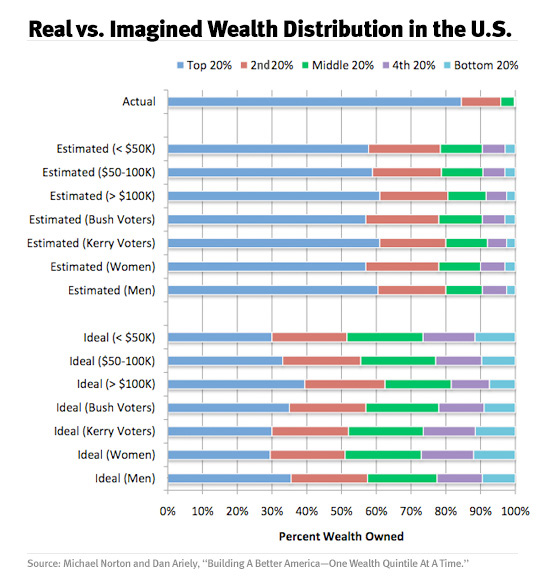10-07-2010, 05:52 PM
Heard about this on NPR this morning:
http://www.slate.com/id/2268872/

http://www.slate.com/id/2268872/
People know we're living in a time of growing income inequality, Krugman told me, but "the ordinary person is not really aware of how big it is." The ignorance hypothesis gets a strong assist from a new paper for the journal Perspectives on Psychological Science: "Building a Better America—One Wealth Quintile at a Time." The authors are Michael I. Norton, a psychologist who teaches at Harvard Business School, and Dan Ariely, a behavioral economist (and blogger) at Duke. Norton and Ariely focus on the distribution of wealth, which is even more top-heavy than the distribution of income. The richest 1 percent account for 35 percent of the nation's net worth; subtract housing, and their share rises to 43 percent. The richest 20 percent (or "top quintile" ) account for 85 percent; subtract housing and their share rises to 93 percent. But when Norton and Ariely surveyed a group whose incomes, voting patterns, and geographic distribution approximated that of the U.S. population, the respondents guessed that the top quintile accounted for only 59 percent of the nation's wealth.
In his book The Wisdom of Crowds, James Surowiecki cites example after example in which collective judgment proves remarkably accurate. When a finance professor polled his class about the number of jelly beans in a jar, individual answers were all over the map, but when he averaged them, the group estimate was less than 3 percent off. When a British statistician reviewed tickets from a contest to guess the weight of an ox at a livestock fair, he found similarly diverse answers, but when he averaged them, the group estimate (1,197 pounds) was less than 0.1 percent off. Such "crowd-sourcing," however, turns out to be a terrible method for estimating the distribution of wealth. Norton and Ariely's respondents were off by 31 percent, even though wealth distribution (unlike income distribution) has remained essentially unchanged for a generation.
Norton and Ariely broke down the responses by income group and found the guesses became slightly more accurate as you moved up the income scale. But more striking was the uniformity among income groups. All five quintiles imagined the top quintile to possess about 60 percent of the nation's wealth. (Again, the real figure is 85 percent.) More surprising still, the average guess of a respondent who'd voted for George W. Bush in the 2004 presidential election was not appreciably different from the average guess of a respondent who'd voted for John Kerry. The Kerry voters imagined the top quintile's share to be larger than the Bush voters did, but again, both figured it was about 60 percent.
Norton and Ariely also asked respondents what they thought the ideal distribution of wealth should be, and found, again, little difference among income groups, or between Bush voters and Kerry voters. Most favored a wealth distribution resembling that in … Sweden! But when you examine Norton and Ariely's method, that particular finding gets a little shaky. They showed respondents three unlabeled pie charts. One depicted utopian equality, with wealth distributed equally among five groups. The second depicted the United States, with wealth distributed very unequally among five groups (one of which gobbled up 85 percent—Norton and Ariely put it at 84 percent, but let's not quibble). The third depicted Sweden, where the top quintile accounts for 35 percent of the nation's wealth. Neither the Swedish pie chart nor the U.S. pie chart was identified by nation. Norton and Ariely were astonished that 47 percent of respondents—remember these were all Americans—chose the pie chart depicting Sweden. But surely most survey-takers, when presented with two extreme options and one that lies in the middle, will instinctively gravitate, like Goldilocks, toward the middle option. More surprising to me was that second place went to Utopia (43 percent). Only 10 percent voted for the pie chart depicting the country the respondents actually live in.







